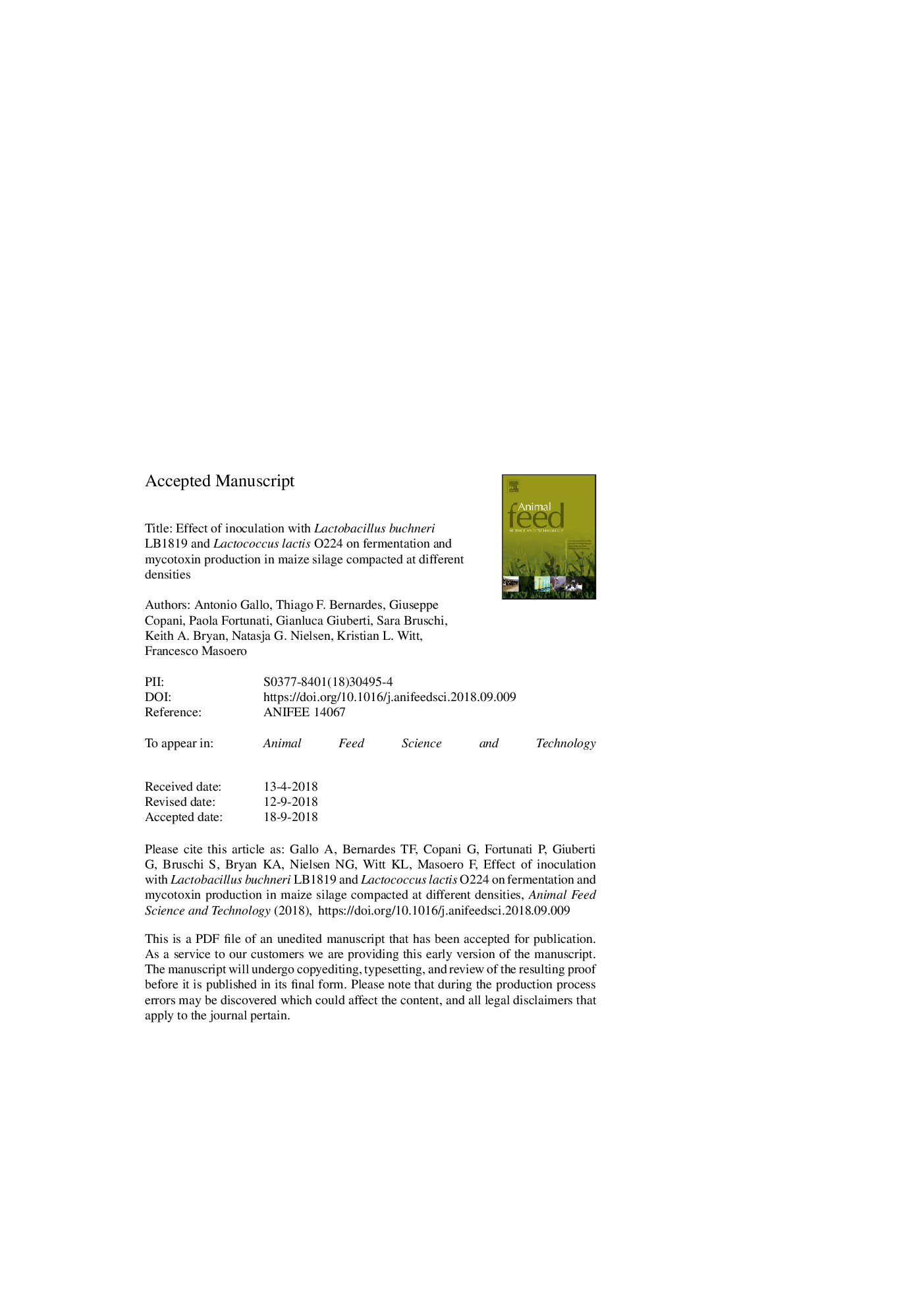| Article ID | Journal | Published Year | Pages | File Type |
|---|---|---|---|---|
| 11001829 | Animal Feed Science and Technology | 2018 | 29 Pages |
Abstract
We examined the effectiveness of a combined inoculant of hetero-fermentative Lactobacillus buchneri LB1819 and homo-fermentative Lactococcus lactis O224 on quality of maize silage at two different densities. The four treatments were: CTR-LD, untreated at low-density (132â±â6âkg DM/m3); CTR-HD, untreated at high density (186â±â6âkg DM/m3); TRT-LD, inoculated at low density; and TRT-HD, inoculated at high density. The 5 replicates for each treatment were ensiled in 20-L plastic jars and the inoculant was applied at a rate of 250,000 CFU/g ensiled forage. The fermentation profile, aerobic stability, and DM losses were measured after 2, 4, 8, 16, and 32 days of ensiling, and the chemical composition, microbial counts, and concentrations of mycotoxins were assessed in the 32 day samples. Data measured once during experiment were analyzed according to a completely randomized design (CRD), with a 2âÃâ2 factorial arrangement of treatments (i.e., inoculation, density, and their interaction). Data measured at different time points were analyzed according to a CRD, with a 2âÃâ2 à 5 factorial arrangement of treatments (i.e., inoculation, density, length of ensiling, and their first or second order interactions). The lactic acid concentration increased (Pâ<â0.05) with the duration of ensiling, with no differences among treatments (overall means on day 2 and day 32: 26.7 and 50.9âg/kg DM, respectively). Aerobic stability was greatest (Pâ<â0.05) in the TRT-HD silage at 32 days. After 32 days of ensiling, soluble crude protein was greater in the CTR-HD and TRT-LD silages than the CTR-LD and TRT-HD silages (Pâ<â0.05, inoculationâÃâdensity interaction). The treatments had similar chemical parameters, yeast and mould counts (overall mean: 4.53 log10 CFU/g and 1.59 log10 CFU/g, respectively). The overall concentration of aflatoxin B1 was 0.412âμg/kg DM. The CTR groups had higher concentrations of fumonisin B2 (413 vs. 278âμg/kg DM, Pâ<â0.05) and roquefortine C (22.81 vs. 3.39âμg/kg DM, Pâ<â0.05) than the TRT groups. Conversely, the CTR groups had lower concentrations of fusaric acid than the TRT groups after 32 days (2849 vs. 4162â¯Î¼g/kg DM, Pâ<â0.05). Both CTR and Lactobacillus buchneri LB1819 and Lactococcus lactis O224 treated samples at a high silage density increased the aerobic stability after 32 days of ensiling (Pâ<â0.05, dayâÃâdensity interaction). Results indicated that inoculation and use of a greater silage density enhanced the fermentation and aerobic stability of maize silage.
Keywords
ADFomaNDFomHeterolactic fermentationVFAZEACRDTRTCTRGLMDeoxynivalenolCFUsBAsLABBiogenic aminesVolatile fatty acidsLactic acid bacteriaHigh densityLow densityAerobic stabilityDONZearalenonecompletely randomized designether extractLignin (sa)lignin determined by solubilization of cellulose with sulphuric aciddry matterGeneral linear modeltotal nitrogencolony forming unitscrude proteinDensityhigh performance liquid chromatographyHPLCGas chromatography
Related Topics
Life Sciences
Agricultural and Biological Sciences
Animal Science and Zoology
Authors
Antonio Gallo, Thiago F. Bernardes, Giuseppe Copani, Paola Fortunati, Gianluca Giuberti, Sara Bruschi, Keith A. Bryan, Natasja G. Nielsen, Kristian L. Witt, Francesco Masoero,
